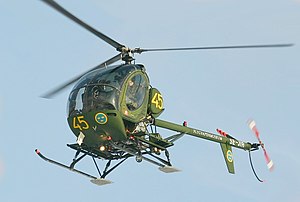Hughes TH-55 Osage
| TH-55 Osage Hughes 269 |
|
|---|---|
 |
|
| A Hughes 269 with the Swedish Air Force Museum | |
| Role | Light utility and trainer helicopter |
| Manufacturer | Hughes Helicopters |
| First flight | 2 October 1956 |
| Primary user | United States Army |
| Produced | 1961–1983 |
| Number built | 2,800 |
| Variants | Schweizer 300 |
The Hughes TH-55 Osage was a piston-powered light training helicopter produced for the United States Army. It was also produced as the Model 269 family of light utility helicopters, some of which were marketed as the Model 300. The Model 300C was produced and further developed by Schweizer after 1983.
In 1955, Hughes Tool Company's Aircraft Division carried out a market survey which showed that there was a demand for a low-cost, lightweight two-seat helicopter. The division began building the Model 269 in September 1955. It was initially designed with a fully glazed cockpit with seating for two pilots, or a pilot and passenger. It also had an open-framework fuselage and a three-blade articulated rotor. The prototype flew on 2 October 1956, but it wasn't until 1960 that the decision was made to develop the helicopter for production. The original truss-work tailboom was replaced with a tubular tailboom and the cockpit was restructured and refined prior to being put into production. With this model, Hughes successfully captured a large portion of the civilian helicopter market with an aircraft that would prove itself popular in agriculture, police work and other duties.
The Hughes 269 was designed with a fully articulated, three-blade main rotor, and a two-blade tail rotor that would remain as distinctive characteristics of all its variants. It also has shock absorber-damped, skid-type landing gear. The flight controls are directly linked to the swashplate of the helicopter so there are no hydraulic systems in the 269. There are generally two sets of controls, although this was optional on the civil 269A. For three-seat aircraft, the middle collective control stick is removable and a seat cushion can be put in its place for the third passenger.
In 1958, prior to full-time production, Hughes provided five preproduction Model 269 examples to the U.S. Army for evaluation as a light observation helicopter to replace the aging OH-13 Sioux and OH-23 Raven. Designated as the YHO-2HU the helicopter was eventually turned down. 9 April 1959, the 269 received certification from the FAA and Hughes continued to concentrate on civil production. With some design changes, deliveries of the Model 269A version began in 1961. By mid-1963 about 20 aircraft were being produced a month and by the spring of 1964, 314 had been built.
...
Wikipedia
